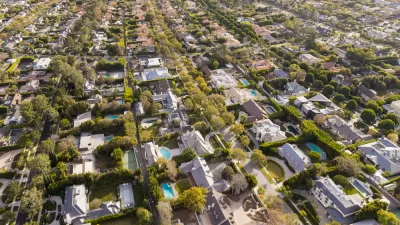Mark Vallianatos argues Los Angeles is still contending with the legacy 1920 era land use restrictions built on racist, exclusionary zoning policies, the remnants of which aren't worth saving.

Politicians fighting for exclusionary zoning that only allows single family homes should consider where these zoning laws come from, Mark Vallianatos argues in the LA Times.
"State Sen. Scott Wiener (D-San Francisco) recently introduced a bill that would help change that. SB 827 would relax some local density and height restrictions and parking requirements on land near busy transit stops,"Mark Vallianatos, writes for the Los Angeles Times. This could make a big difference in a city where almost half of the land is zoned exclusively for single family housing.
L.A.'s Mayor and City Council came out against the measure citing a change in the city's character, Mayor Garcetti suggested that neighborhoods with 2-3 flats and apartment buildings wouldn't "look right" in LA. Vallianatos finds that line of reasoning unconvincing. Citing the charm of Northeast L.A. with "the mix of duplexes, bungalow courts, single-family houses, dingbat apartments and townhome-style small-lot subdivisions."
Worse, the exclusionary zoning laws put in place in LA in 1921 were part of a movement started in the south to codify segregation. When the courts made it illegal to ban races and religious groups from neighborhoods, the movement used single-family housing zoning rules as an end-around to circumvent those rules. These land use rules have constrained housing in the city ever since, and Vallianatos argues, "In a region with a housing shortage and homelessness crisis, all homes are good homes."
FULL STORY: L.A.'s land use rules were born out of racism and segregation. They're not worth fighting for

Maui's Vacation Rental Debate Turns Ugly
Verbal attacks, misinformation campaigns and fistfights plague a high-stakes debate to convert thousands of vacation rentals into long-term housing.

Planetizen Federal Action Tracker
A weekly monitor of how Trump’s orders and actions are impacting planners and planning in America.

In Urban Planning, AI Prompting Could be the New Design Thinking
Creativity has long been key to great urban design. What if we see AI as our new creative partner?

King County Supportive Housing Program Offers Hope for Unhoused Residents
The county is taking a ‘Housing First’ approach that prioritizes getting people into housing, then offering wraparound supportive services.

Researchers Use AI to Get Clearer Picture of US Housing
Analysts are using artificial intelligence to supercharge their research by allowing them to comb through data faster. Though these AI tools can be error prone, they save time and housing researchers are optimistic about the future.

Making Shared Micromobility More Inclusive
Cities and shared mobility system operators can do more to include people with disabilities in planning and operations, per a new report.
Urban Design for Planners 1: Software Tools
This six-course series explores essential urban design concepts using open source software and equips planners with the tools they need to participate fully in the urban design process.
Planning for Universal Design
Learn the tools for implementing Universal Design in planning regulations.
planning NEXT
Appalachian Highlands Housing Partners
Mpact (founded as Rail~Volution)
City of Camden Redevelopment Agency
City of Astoria
City of Portland
City of Laramie





























